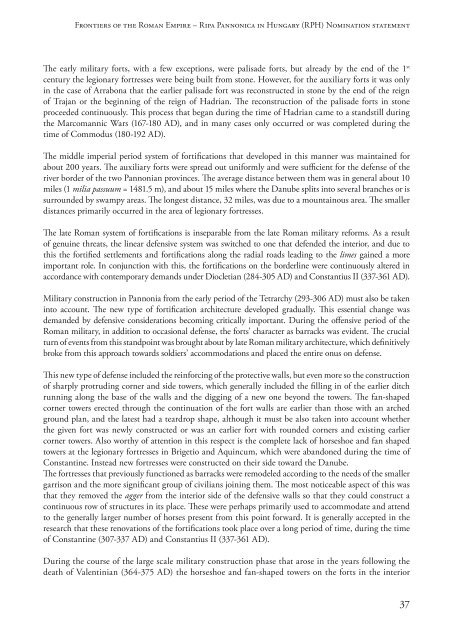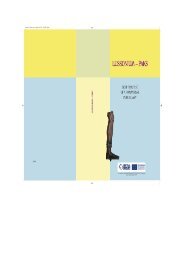the PDF version! - Danube Limes
the PDF version! - Danube Limes
the PDF version! - Danube Limes
You also want an ePaper? Increase the reach of your titles
YUMPU automatically turns print PDFs into web optimized ePapers that Google loves.
Frontiers of <strong>the</strong> Roman Empire – Ripa Pannonica in Hungary (RPH) Nomination statement<br />
The early military forts, with a few exceptions, were palisade forts, but already by <strong>the</strong> end of <strong>the</strong> 1 st<br />
century <strong>the</strong> legionary fortresses were being built from stone. However, for <strong>the</strong> auxiliary forts it was only<br />
in <strong>the</strong> case of Arrabona that <strong>the</strong> earlier palisade fort was reconstructed in stone by <strong>the</strong> end of <strong>the</strong> reign<br />
of Trajan or <strong>the</strong> beginning of <strong>the</strong> reign of Hadrian. The reconstruction of <strong>the</strong> palisade forts in stone<br />
proceeded continuously. This process that began during <strong>the</strong> time of Hadrian came to a standstill during<br />
<strong>the</strong> Marcomannic Wars (167-180 AD), and in many cases only occurred or was completed during <strong>the</strong><br />
time of Commodus (180-192 AD).<br />
The middle imperial period system of fortifications that developed in this manner was maintained for<br />
about 200 years. The auxiliary forts were spread out uniformly and were sufficient for <strong>the</strong> defense of <strong>the</strong><br />
river border of <strong>the</strong> two Pannonian provinces. The average distance between <strong>the</strong>m was in general about 10<br />
miles (1 milia passuum = 1481.5 m), and about 15 miles where <strong>the</strong> <strong>Danube</strong> splits into several branches or is<br />
surrounded by swampy areas. The longest distance, 32 miles, was due to a mountainous area. The smaller<br />
distances primarily occurred in <strong>the</strong> area of legionary fortresses.<br />
The late Roman system of fortifications is inseparable from <strong>the</strong> late Roman military reforms. As a result<br />
of genuine threats, <strong>the</strong> linear defensive system was switched to one that defended <strong>the</strong> interior, and due to<br />
this <strong>the</strong> fortified settlements and fortifications along <strong>the</strong> radial roads leading to <strong>the</strong> limes gained a more<br />
important role. In conjunction with this, <strong>the</strong> fortifications on <strong>the</strong> borderline were continuously altered in<br />
accordance with contemporary demands under Diocletian (284-305 AD) and Constantius II (337-361 AD).<br />
Military construction in Pannonia from <strong>the</strong> early period of <strong>the</strong> Tetrarchy (293-306 AD) must also be taken<br />
into account. The new type of fortification architecture developed gradually. This essential change was<br />
demanded by defensive considerations becoming critically important. During <strong>the</strong> offensive period of <strong>the</strong><br />
Roman military, in addition to occasional defense, <strong>the</strong> forts’ character as barracks was evident. The crucial<br />
turn of events from this standpoint was brought about by late Roman military architecture, which definitively<br />
broke from this approach towards soldiers’ accommodations and placed <strong>the</strong> entire onus on defense.<br />
This new type of defense included <strong>the</strong> reinforcing of <strong>the</strong> protective walls, but even more so <strong>the</strong> construction<br />
of sharply protruding corner and side towers, which generally included <strong>the</strong> filling in of <strong>the</strong> earlier ditch<br />
running along <strong>the</strong> base of <strong>the</strong> walls and <strong>the</strong> digging of a new one beyond <strong>the</strong> towers. The fan-shaped<br />
corner towers erected through <strong>the</strong> continuation of <strong>the</strong> fort walls are earlier than those with an arched<br />
ground plan, and <strong>the</strong> latest had a teardrop shape, although it must be also taken into account whe<strong>the</strong>r<br />
<strong>the</strong> given fort was newly constructed or was an earlier fort with rounded corners and existing earlier<br />
corner towers. Also worthy of attention in this respect is <strong>the</strong> complete lack of horseshoe and fan shaped<br />
towers at <strong>the</strong> legionary fortresses in Brigetio and Aquincum, which were abandoned during <strong>the</strong> time of<br />
Constantine. Instead new fortresses were constructed on <strong>the</strong>ir side toward <strong>the</strong> <strong>Danube</strong>.<br />
The fortresses that previously functioned as barracks were remodeled according to <strong>the</strong> needs of <strong>the</strong> smaller<br />
garrison and <strong>the</strong> more significant group of civilians joining <strong>the</strong>m. The most noticeable aspect of this was<br />
that <strong>the</strong>y removed <strong>the</strong> agger from <strong>the</strong> interior side of <strong>the</strong> defensive walls so that <strong>the</strong>y could construct a<br />
continuous row of structures in its place. These were perhaps primarily used to accommodate and attend<br />
to <strong>the</strong> generally larger number of horses present from this point forward. It is generally accepted in <strong>the</strong><br />
research that <strong>the</strong>se renovations of <strong>the</strong> fortifications took place over a long period of time, during <strong>the</strong> time<br />
of Constantine (307-337 AD) and Constantius II (337-361 AD).<br />
During <strong>the</strong> course of <strong>the</strong> large scale military construction phase that arose in <strong>the</strong> years following <strong>the</strong><br />
death of Valentinian (364-375 AD) <strong>the</strong> horseshoe and fan-shaped towers on <strong>the</strong> forts in <strong>the</strong> interior<br />
37











